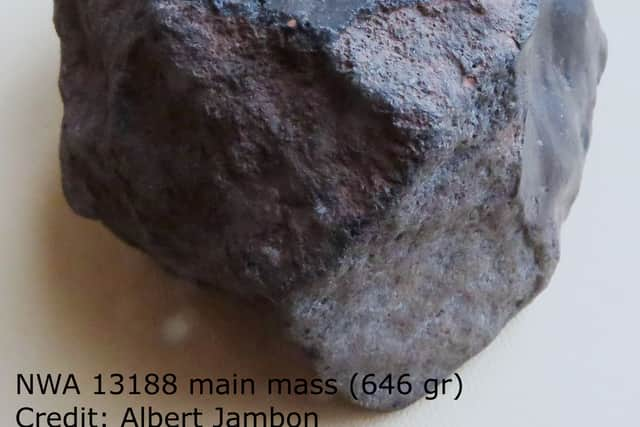Boomerang meteorite left Earth, spent time in space and now has appeared back on land
and live on Freeview channel 276
Scientists are confirming if a black meteorite discovered in Morocco in 2018 originated on Earth, before being blasted into space and returning back to land thousands of years later.
If this is confirmed, this will be the first boomerang space rock ever discovered.
Advertisement
Hide AdAdvertisement
Hide AdThe rock, named 'Northwest Africa (NWA) 13188', is around 646 grams, and has a bubbly appearance. The texture of the crystals on the rock, and its chemical makeup suggests it is the type of rock which forms from the molten minerals produced by volcanoes near sinking ocean plates - on Earth.
Also found is a mix of oxygen isotopes and signature of trace elements, which cast doubt on whether it is an ordinary meteorite.


How was this meteorite found?
Jérôme Gattacceca, a geophysicist from the French French National Centre for Scientific Research, presented the team's findings at the Goldschmidt geochemistry conference in France.
The team has concluded the rock has seen a significant amount of time in space, as it has concentrations of Helium-3, Beryllium-10, and Neon-21 - which could only be explained by exposure to cosmic rays.
Advertisement
Hide AdAdvertisement
Hide AdHowever, the isotypes were lower than in other meteorites but were higher than other rocks from Earth, which suggests that NWA 13188 had been exposed to galactic cosmic rays for a short period - such as a few tens of thousands of years.
The rock also has a glassy 'fusion crust' suggesting it may have melted as it entered Earth.
"Therefore, we consider NWA 13188 to be a meteorite, launched from the Earth and later re-accreted to its surface," they wrote.
How was this rock flung into space?
How the rock made it into space is still a mystery, but the researchers suggest that it could have been ejected during a volcanic eruption, or thrown into space as another meteorite smashed into Earth.
Advertisement
Hide AdAdvertisement
Hide AdHowever, to get into space via a volcanic eruption, it would need to move at tens of thousands of kilometres per hour and the highest volcano plumes only reach around 31-45 kilometres above the Earth.
Yet, some collisions between Earth and large asteroids would be strong enough to launch rocks into the Solar System as a 4-billion-year-old Earth rock was found on the Moon during the Apollo 14 mission in 1971. This rock was probably fired from Earth to the then much-closer Moon after an asteroid collision.
The age of the rock is unknown but the team is working on dating the rock by measuring the concentrations of an isotope of argon.
Comment Guidelines
National World encourages reader discussion on our stories. User feedback, insights and back-and-forth exchanges add a rich layer of context to reporting. Please review our Community Guidelines before commenting.
